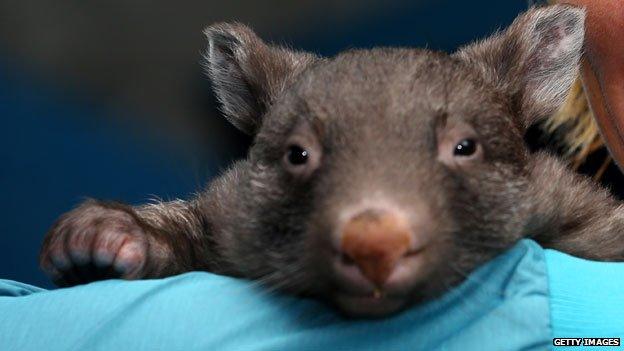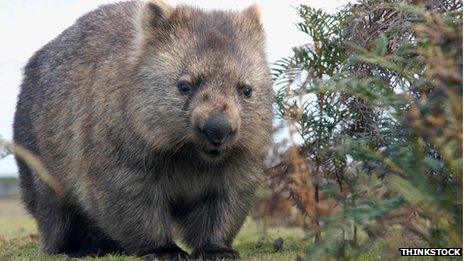Australia's wombats struggling to survive
- Published

The wombat is in trouble. Some are dying in bushfires, or being shot by farmers. Others are scratching themselves to death because of a mite infection. Only 115 of one species - the northern hairy-nosed wombat - remain alive in the wild.
"He was quite some flatmate - he took over the house, moved my fridge, re-arranged the furniture and then dug a hole right through the living room floor," said Ian, a wildlife volunteer who works in the Blue Mountains, 60km (37 miles) west of Sydney.
Ian was telling me about an infant wombat he had recently hand-reared, after its mother was hit and killed by a car.
"You get so attached to the cute little babies," he admitted. "It is my own fault - I should have released him back into the wild earlier."
Ian explained that the now-adult wombat had found new digs in the vast national park nearby.
Wombats are marsupials and are endemic to Australia. They are found nowhere else.

A wombat looks like an overgrown, stocky guinea pig, covered with thick grey fur and with a wide, flat, broad forehead. Fully-grown adults are about a metre long (3ft 2in) and about half a metre tall (1ft 6in). They weigh about 40kg (88lb).
But while their looks are pretty straightforward, people throughout history have found it less easy to understand their behaviour.
The Aborigines seem to have mixed feelings about them, using stories to try to explain why they are nocturnal and live underground. Legends describe the wombat as boastful, sometimes wise, but also stubborn and selfish.
According to one story, the wombat was once a giant, who dared to boast he was more powerful than the sun. After a contest of might, however, the wombat lost, and so today hides from shame, deep down in a burrow.
But another Aboriginal story tells of how wise the wombat can be. He comforts the other animals in the forest, after their friend, a cockatoo, has died, explaining to them all about forest spirits.
Wombats are fearsomely strong diggers, with very muscular front legs and sharp claws, usually used to excavate winding tunnels for their homes.
Yet despite their robust appearance, these animals are struggling to survive.
Many have been infected by a foreign mite, from foreign foxes, introduced for hunting by the early English settlers of Australia. Scabby tissue forms over the wombats' eyes and ears, and infections occur, ultimately causing their death.
Phil Borchard, a scientist, took me to see a family of Common Wombats living by the Shoalhaven river in southern New South Wales.
"Many are literally scratching themselves to death," he told me.
It was in the middle of the day, but still, one male wombat was out of its burrow, sick and looking for grass to eat. Its lovely, lush fur was all scratched away, leaving red skin, raw and sore.
What is more, it is still legal for Australian farmers to obtain a licence to shoot wombats - even though they are officially a "protected" species.
There are, in fact, three species of wombat: the Common wombat, the Southern Hairy Nosed and the Northern Hairy Nosed.
Of these three, conservationists are now most worried about the survival of the Northern Hairy Nosed. There are only 115 left in the wild, living in just one forest in Central Queensland.

Kangaroos and wombats are a common sighting on Australian roads
This population of wombats is so small that the group is becoming inbred. Competition with cattle and sheep for grass to eat, drought, bushfires, as well as dingo and feral dog attacks have all whittled away wombat numbers.
But fortunately, a group of committed volunteers and scientists, working with the Queensland state government, has now put up fences to protect the wombats from predators, made tunnels for extra shelter, and is working with zoos to create breeding programmes.
These conservationists are well aware they have little time left.
When I met up with Ian again, back in the Blue Mountains, he had another new flatmate. In his arms was a tiny Common Wombat in a blanket, rescued from the pouch of its dead mother, another victim of a car.
"How can you not love this creature, and want to save it?" Ian asked me.
The tiny wombat had its eyes shut, snoring, completely oblivious to the troubles ahead which are threatening his ancient family's survival.
How to listen to From Our Own Correspondent, external:
BBC Radio 4: Saturdays at 11:30 and some Thursdays at 11:00
Listen online or download the podcast.
BBC World Service: Short editions Monday-Friday - see World Service programme schedule.
You can follow the Magazine on Twitter, external and on Facebook, external